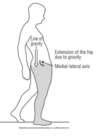Posture and Gait Review Flashcards
(42 cards)
Posture and Gait
Postural pattern?

Kyphosis – Lordosis posture
Posture and Gait
Kyphosis – Lordosis posture: elongated and shortened muscles

- Enlongated: neck flexors, upper back, external oblique, hamstrings
- Shortened: neck extensors, low back extensors, hip flexors
Posture and Gait
Postural pattern?

Flat-back posture
Posture and Gait
Flat-back posture: elongated and shortened muscles

- Elongated: hip flexors
- Shortened: hamstrings
Posture and Gait
postural pattern?

Sway back posture
Posture and Gait
Sway back posture: elongated and shortened muscles
- Elongated: hip flexors, external obliques, upper back extensors, neck flexors
- Shortened: hamstrings, upper portion of internal obliques

Posture and Gait
postural pattern?

lordosis posture

Posture and Gait
lordosis posture: elongated and shortened muscles
- elongated: anterior abdominal, hamstrings
- shortened muscles: low back, hip flexors

Posture and Gait
ideal posture by Kendall et al
- post coronal suture
- Through the external auditory meatus
- odontoid process
- middle of shoulder joint
- bodies of lumbar vertebrae
- sacral promontory
- slightly posterior to center of hip joint
- slightly ant to the axis of knee joint
- slightly ant to lat malleolus
- Through the calcaneocuboid joint

Posture and Gait
What is the role of the pelvis in gait in the sagittal plane?
Pelvic Tilt (sagiIal plane): 2.79° to 4°

Posture and Gait
What is the role of the pelvis in gait in the frontal plane?
Pelvic drop/list (frontal plane): 4° to 7.72°

Posture and Gait
What is the role of the pelvis in gait in the transverse plane?
Pelvic rotation (transverse plane): 10° to 10.4°

Posture and Gait
Characterized by a shorter step length and stance time on the side of the painful lower extremity; it may be accompanied by ipsilateral trunk lean with hip pain or a contralateral trunk lean with knee and foot pain.
Antalgic Gait
Posture and Gait
anything that makes the initiation of swing difficult: decreased trunk stability, inefficient AE of the pelvis, difficulty with hip flexion etc…
Backward trunk lean during initial swing
Posture and Gait
anything that makes the initiation of swing difficult (except the trunk control): inefficient AE of the pelvis, difficulty with hip flexion
Posterior pelvic tilt during initial swing
Posture and Gait
a relatively longer leg will create what type of deviation?
circumduction gait
Posture and Gait
Prosthetic Gait: abducted gait during stance
- avoiding a pinch
- or clearing a long leg
Posture and Gait
Prosthetic Gait: adducted gait during stance
fit of the prosthesis
Posture and Gait
limping gait, avoiding putting weight on the limb
antalgic gait
Posture and Gait
backward trunk lean during initial swing

- any weakness for initiation of swing
- Purposeful to reduce demands on weakened stance limb gluteus maximus
- or to assist with limb advancement when hip flexion capability is limited.
- decreased trunk stability
Posture and Gait
Forward trunk lean during stance

- Compensation for quadriceps weakness. Forward lean reduces knee extensor moment and thus demand on vastii.
- May also be used to accommodating hip or knee flexion contractures.
Posture and Gait
pelvic hike during swing

Action of quadratus lumborum to assist with limb clearance when hip flexion, knee flexion, and/or ankle dorsiflexion are inadequate for limb clearance.
Posture and Gait
Ipsilateral pelvic drop during swing
- Contralateral hip abductor weakness
- hip adductor spasticity
- or hip adduction contracture.
Posture and Gait
Compensation for weak hip flexors or for inability to shorten leg for limb clearance
circumduction










